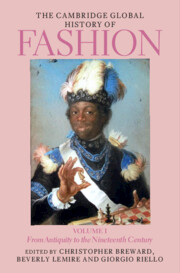Book contents
- The Cambridge Global History of Fashion
- The Cambridge Global History of Fashion
- The Cambridge Global History of Fashion
- Copyright page
- Contents for Volume I
- Figures for Volume I
- Maps for Volume I
- Table for Volume I
- Contributors for Volume I
- Preface
- 1 Global History in the History of Fashion
- Part I Multiple Origins of Fashion
- Part II Early Modern Global Entanglements
- Part III Many Worlds of Fashion
- 13 ‘Black Cloth’
- 14 Fashion and Moral Concern in Early Modern Japan
- 15 Textiles and Fashion in Southeast Asia
- 16 Fashion in Ming and Qing China
- 17 Everyday Fashion in the Ottoman Empire,C. 1600–1800
- 18 Imperialism and Fashion: South Asia, c. 1500–1800
- 19 Fashion Systems in the Indian Ocean World, from Ancient Times to c. 1850
- 20 Fashion and First Peoples in European Settler Societies, c. 1700–1850
- Index
- References
18 - Imperialism and Fashion: South Asia, c. 1500–1800
from Part III - Many Worlds of Fashion
Published online by Cambridge University Press: 04 August 2023
- The Cambridge Global History of Fashion
- The Cambridge Global History of Fashion
- The Cambridge Global History of Fashion
- Copyright page
- Contents for Volume I
- Figures for Volume I
- Maps for Volume I
- Table for Volume I
- Contributors for Volume I
- Preface
- 1 Global History in the History of Fashion
- Part I Multiple Origins of Fashion
- Part II Early Modern Global Entanglements
- Part III Many Worlds of Fashion
- 13 ‘Black Cloth’
- 14 Fashion and Moral Concern in Early Modern Japan
- 15 Textiles and Fashion in Southeast Asia
- 16 Fashion in Ming and Qing China
- 17 Everyday Fashion in the Ottoman Empire,C. 1600–1800
- 18 Imperialism and Fashion: South Asia, c. 1500–1800
- 19 Fashion Systems in the Indian Ocean World, from Ancient Times to c. 1850
- 20 Fashion and First Peoples in European Settler Societies, c. 1700–1850
- Index
- References
Summary
What (not) to wear? A mirza should never wear brocade or cloth of gold; these are beneath his dignity, intended for adorning domestic spaces, not the body. In winter, a shawl – plain or imprinted with gold and silver leaves – would keep out the cold over garments of Indian material fastened with pearl buttons, ‘for pearl is natural while other jewels have to be cut’. In summer, ‘when he sits on a wooden seat with a white covering, he should wear the silver-threaded cap round the head and ears […] and a silver threaded upper garment (bala-band)’.1 From its initial use as a title for princes or noblemen, mirza had become the watchword of (courtly) refinement, denoting a gentlemanly bearing by the seventeenth century. Flushed with cash through burgeoning trade, the Mughal Empire reached its zenith; home to an increasingly cosmopolitan nobility whose ranks had increased rapidly, an expanding population of theologians and administrators, and a prosperous mercantile elite.
- Type
- Chapter
- Information
- The Cambridge Global History of FashionFrom Antiquity to the Nineteenth Century, pp. 599 - 629Publisher: Cambridge University PressPrint publication year: 2023



